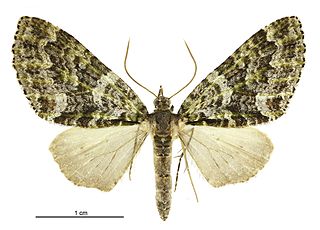
Tatosoma is a genus of moths in the family Geometridae first described by Arthur Gardiner Butler in 1874. The species in this genus are found only in New Zealand.

Sabatinca lucilia is a species of moth in the family Micropterigidae. It is endemic to New Zealand and is found in the top half of the North Island. The adults of this species are on the wing from the end of November until the beginning of March. The larvae of this species likely feed on foliose liverwort species with the adults likely feeding on fern spores or sedge pollen. Adults have been found on a sunny moss-covered clay bank. The species can be found in multiple forest types such as kauri, kanuka and Nothofagus and prefers to inhabit damp fern covered banks

Asterivora chatuidea is a moth of the family Choreutidae. It is endemic to New Zealand and has been collected in and around Dunedin. The larvae of this species are leaf miners and hosts include Helichrysum lanceolatum, Olearia quinquevulnera and Pseudognaphalium luteoalbum. Adults of this species has been recorded as being on the wing in November, January and February.
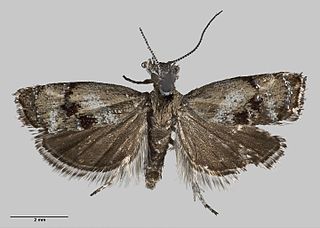
Asterivora urbana is a species of moth in the family Choreutidae. It is endemic to New Zealand and has been observed in Arthur's Pass. Adults are on the wing in January.

Heterocrossa sanctimonea is a moth of the Carposinidae family first described by Charles E. Clarke in 1926. It is endemic to New Zealand.

Rhathamictis nocturna is a moth of the Psychidae family. This species was described by Charles Edwin Clarke in 1926. It is endemic to New Zealand and has been collected in the Auckland region. Larvae of this species build small protective cases in which they hide and from which they feed. Adults have been observed on the wing in November and January.

Tatosoma agrionata, also known as the mistletoe carpet moth, is a species of moth in the family Geometridae first described by Francis Walker in 1862. It is endemic to New Zealand. It is classified as at risk, declining by the Department of Conservation.

Mallobathra abyssina is a moth of the family Psychidae. It was described by Charles Edwin Clarke in 1934. This species is endemic to New Zealand and has been observed in the West Coast Region. Adults are on the wing in January.

Mallobathra is a genus of moths belonging to the family Psychidae, and are bagworm moths. This genus was first described by Edward Meyrick. It is endemic to New Zealand. The type species of this genus is Mallobathra crataea.

Mallobathra cataclysma is a moth of the family Psychidae. It was described by Charles Edwin Clarke in 1934. This species is endemic to New Zealand and has been observed in Otago. Adults are on the wing in January and have been collected just before sunrise at the bushline in native Nothofagus forest.

Mallobathra memotuina is a moth of the family Psychidae. It was described by Charles Edwin Clarke in 1934.This species is endemic to New Zealand and has been observed in and around Dunedin. Adults are on the wing in November and December and have been collected just before sunrise.
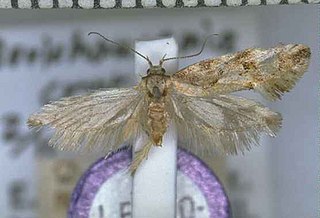
Tingena crotala is a species of moth in the family Oecophoridae. It is endemic to New Zealand and is found both in the North and South Islands. This species inhabits native forest and is on the wing in November and December.
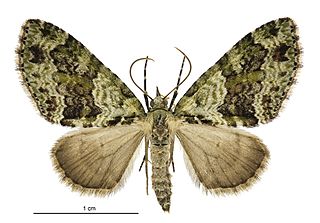
Tatosoma alta is a species of moth in the family Geometridae first described by Alfred Philpott in 1913. It is endemic to New Zealand.
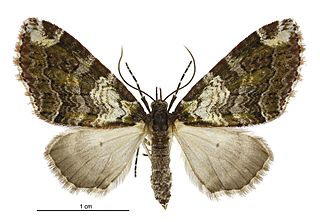
Tatosoma apicipallida is a species of moth in the family Geometridae first described by Louis Beethoven Prout in 1914. It is endemic to New Zealand. The larval host plant of this species is unknown. It has been found from Mount Te Aroha southwards.

Tatosoma fasciata is a species of moth in the family Geometridae first described by Alfred Philpott in 1914. It is endemic to New Zealand. This moth has been observed at Mount Te Aroha, which is possibly the northern most location this species is found. The larval host plant of this species is Lophozonia menziesii.
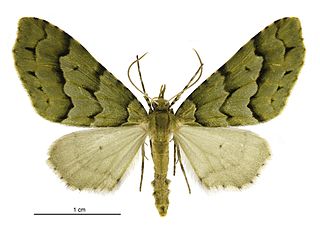
Tatosoma lestevata is a species of moth in the family Geometridae first described by Francies Walker in 1862. It is endemic to New Zealand.
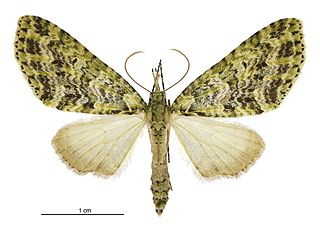
Tatosoma tipulata, also known as the kāmahi green spindle, is a species of moth in the family Geometridae. It was first described by Francis Walker in 1862. It is endemic to New Zealand and occurs in the North, South and Stewart Islands. This species inhabits native bush. The larvae have been recorded as feeding on Pterophylla racemosa, Nothofagus cliffortioides and Podocarpus totara. Adult moths are most commonly observed on the wing from September until March. Adults are nocturnal and are slightly attracted to light. They have also been collected via sugar traps. During the day adults can often be observed resting, camouflaged against moss and lichens, on the trunks of trees.
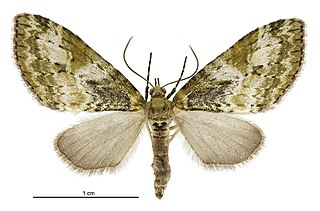
Tatosoma topea is a species of moth in the family Geometridae first described by Alfred Philpott in 1903. It is endemic to New Zealand.
Charles Edwin Clarke was a New Zealand dentist and amateur entomologist, who specialised in collecting lepidoptera and coleoptera.


















